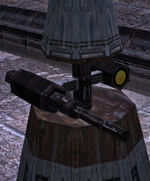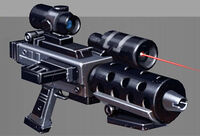| | |
The popular stormtrooper-issue BlasTech Industries E-11 blaster rifle.
- "Hokey religions and ancient weapons are no match for a good blaster at your side, kid."
- ―Han Solo, to Luke Skywalker on the supposed advantages of a blaster over a lightsaber
A blaster was a ranged weapon that fired bursts of particle beam energy called blaster bolts from a replaceable power pack. The most commonly used weapon in the galaxy, blasters' intense beams consisted of compacted high-energy particles and intense light that could kill or paralyze their target, depending on the setting. Blasters ranged from compact pistols, all the way up to large, heavy rifles and starship-mounted blaster cannons. Some beings used blasters from their youth: Anakin Skywalker owned a small ion blaster in his childhood, Leia Organa was given a sporting blaster when she was a teenager, and Mandalorian children were given blasters, along with extensive training, prior to becoming thirteen standard years old. Throughout the Clone Wars, a clone trooper usually held a blaster rifle if not any type of specialist.
Technical information
The term blaster was often used interchangeably with the term laser in everyday conversation, both denoting the same type of particle beam weapon. However, strictly speaking, the laser was a much older weapon design than the blaster. And, unlike those of lasers, blasters' firing cycles had more proficient recharge rates, allowing them to attain a much higher rate of fire, though at a loss of range and accuracy.
There was also some dispute as to which size restrictions denoted a "blaster". For example, blasters were commonly thought of as handheld weapons only, but starship-mounted blaster cannons could fall into this category as well.
Laser mechanics

A common DH-17 blaster pistol used by the Rebellion.
A laser beam was a coherent shaft of light. When referring to light (or any other wave pattern for that matter), coherence referred to the pattern's uniformity in multiple waves. In other words, each light wave emitted from the laser device had the same wavelength and amplitude as all other waves emitted from the same device, and all "crests" and "troughs" of every wave were aligned with the others.
Lasers were generated by stimulating a "gain medium"; this substance was charged with electricity, radiation or even by chemical reaction so as to release energy in the form of photons. The gain medium could come in the form of a solid (often a crystal), liquid or gas (Tibanna gas was reputedly a favored medium). The "gain medium", when charged, saw the rapid excitement of its constituent atoms. These atoms would experience increases in electron energy levels. Said electrons, seeking equilibrium, then released photons, or packets of electromagnetic radiation, so as to self-stabilize. The produced radiation, reflected and amplified by the optical cavity could then be released as a high-powered and potentially destructive beam of coherent radiation. The output coupler was responsible for the release of the beam from the optical cavity.
Blaster mechanics
Dual blasters on a droideka.
Blasters were a considerable improvement over the archaic laser design. Instead of a coherent beam of light, the blaster fired a compressed, focused, high-energy particle-beam that was very destructive, commonly referred to as a "bolt". The composition and characteristics of the blaster bolt could vary depending on the means used to produce it.
The less common blaster was a plasma based design, like those used by the Grand Army of the Republic. Plasma-based blasters were effective against all targets, but even more so against droids because of the nature of plasma as a superheated, ionized gas. Droids were vulnerable to ion energy, so ion weapons are a natural choice against a droid army. This explained the use of the BlasTech DC-series in the Clone wars.
In plasma-based blasters, a high-energy gas (tibanna gas, for example, used in the BlasTech DC-series) would move from the gas chamber into another chamber where it was altered into a plasma state. It was then released from a magnetic "bottle" effect through the collimating components. This turned the mass of plasma gas and energy into a coherent energy beam as a coherent energy bolt of light and plasma. This combination of light and plasma formed the deadly bolt fired from a blaster.
The more common type was the blaster that fired a high energy particle beam that was more deadly to humanoids and other biological targets than superheated plasma (which was quite deadly anyway), but it was still effective enough against droids to put a B1 battle droid down and keep it down. Particle-beam types were also more efficient because they used less blaster gas to produce the beam than was necessary to form a plasma bolt, as plasma, as a state of matter, required a far greater amount of energy to produce.
In particle-beam based blasters, like the E-11 used by stormtroopers, a small amount of high-energy gas moved from the Heter valve to the chamber commonly called the XCiter. In the XCiter chamber, the gas was energized by the power pack, then passed into the actuating blaster module, which, when assisted by the components in the barrel, processed the now extremely high-energy gas into a compressed beam of intense energy particles, coupled with intense light, which generated the deadly high-energy particle beam fired from most blasters. In these blasters, the combination of super hot laser-light and a compressed bolt of intense energy particles formed the deadly bolt.

Han Solo's iconic and illegally modified DL-44 heavy blaster pistol.
Most personal blasters had two kinds of ammunition: a gas cartridge and a power cell. Less powerful weapons, like the Drearian Defense Conglomerate Defender sporting blaster pistol, relied largely on the power cell and used only a small quantity of gas, while very powerful weapons, like the illegal Tenloss DX-2 disruptor pistol, used much larger amounts of gas. Still other weapons, namely those dating from earlier times, employed a kind of removable power cell/cartridge which supplies enough energy (though at weaker levels) to make total expenditure seldom.
Blaster bolts usually dissipated in a small, but violent, explosion of extreme heat and force upon contact with an unshielded surface, sometimes leaving blast points. Weapons such as Han Solo's DL-44 heavy blaster pistol and the E-11 blaster rifle could cause incredible destruction, and had the power to blow large chunks from stone walls and smaller holes and pockmarks out of durasteel bulkheads, as seen in Han Solo and Luke Skywalker's raid on Detention Block AA-23. An ion accelerator used an electrical charge to stun or kill enemies.
Electronic enhancements
Many blasters had side attachments and accessories to aid in targeting, accuracy, rate of fire, and grip. Some known attachments included targeting lasers, electronic scopes, and larger power packs. Delta Squad's DC-17m interchangeable blasters had sniper and anti-armor attachments for adaptability in unpredictable situations. Boba Fett's EE-3 carbine rifle had a small scope which could interface with Fett's helmet for increased accuracy. Jango Fett's two WESTAR-34 blaster pistols had dallorian alloy plating, which kept the weapon from overheating. Clone trooper's DC-15A blasters could interface with their helmets.
History and usage
- "So uncivilized."
- ―Obi-Wan Kenobi, after killing General Grievous with the latter's own weapon.

Earliest known type of blaster.
The oldest known type of blaster was used by an ancient droid of an unknown model employed by the Rakatan Infinite Empire. This weapon was considered to be extremely up-to-date compared to the blasters of the year 3956 BBY. Besides that, the oldest and most venerable example of blaster technology was the triple blaster, which dates back to the Galactic Republic. It worked by using three separate blasters connected to the same targeting system, often coordinated in sets of two or four and fired simultaneously at a target. Triple blasters had become exceedingly rare by the beginning of the rise of the Empire. Prior to the innovation of the triple blaster, beam-tubes were used. They consisted of backpacks with a hose coming out of the side that connected to a focusing tube. All of the equipment that created the blaster beam was contained in the backpack and was fired out of the hose. These lost popularity quickly once triple blasters were invented.
Triple blaster technology began to wane as what is traditionally thought of as "the blaster" was created, as it was a self-contained unit that could produce bolts by itself with no additional equipment.
An updated version of blaster technology was the autoblaster. Designed for the B-wing starfighter, it had an even higher rate of fire than other blasters but did not become commonly available until after the Battle of Endor.
The most common personal weapon in the galaxy by the rise of the Empire, blasters were often used not only by military personnel, but by civilians as protection. They were more commonly seen in the Outer Rim worlds, though small, concealable Hold-out blasters were frequently used by social elite, such as Baron Administrator Lando Calrissian. Many establishments, such as the Cantina in Mos Eisley had restrictions against use of blasters, though these were often overlooked if the conflict remains small.
The most common manufacturer of blasters during the Galactic Civil War was BlasTech, which had contracts with both the Imperial Military and the Alliance to Restore the Republic. It also manufactured the Protector civilian fighter-grade blaster line.
Blaster variants

A blaster c. 3,656 BBY.
Appearances
Non-canon appearances
- LEGO Star Wars: The Phantom Menace
- LEGO Star Wars: The Video Game
- LEGO Star Wars: The Complete Saga
- LEGO Star Wars III: The Clone Wars
- LEGO Star Wars: Darth Maul's Mission
- LEGO Star Wars: The Quest for R2-D2 game
- LEGO Star Wars: The Quest for R2-D2 film
- LEGO Star Wars: The Yoda Chronicles video game
- LEGO Star Wars: Microfighters video game
- LEGO Star Wars: Microfighters Episode 2: Tank Attack Antics
- LEGO Star Wars: Revenge of the Brick
- LEGO Star Wars II: The Original Trilogy
- LEGO Star Wars: Bombad Bounty
- LEGO Star Wars Microfighters Episode 3: Rebel Rally Time
- LEGO Star Wars: The Padawan Menace
Sources
See also
External links
- Technical Commentaries entry on blasters
- Site with information on many kinds of blasters
- Template:SWSB
- www.imfb.org Blasters Site with many pictures of blasters from the movies

